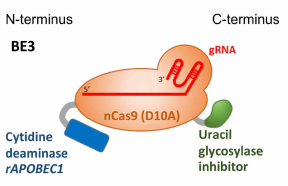Due to the fact that HDR (homology directed repair) occurs at a relatively low frequency especially in nondividing cells compared to NHEJ (non-homologous end joining), scientists have developed advanced CRISPR/Cas9 systems called CRISPR base editors that induce single nucleotide change at target loci without the need for double stranded break formation or a donor DNA template provision. Lifeasible has applied them successfully in monocots and dicots such as wheat, rice, maize, Arabidopsis, and tomato.
CRISPR base editors contain catalytically inactive dCas9 (dead Cas 9) or nCas9 (Cas9 nickase) and a cytidine deaminase or adenine deaminase. The CBEs (cytidine base editors) can convert cytosine to uracil, which is subsequently converted to thymine through DNA replication or repair. Similarly, ABEs (adenine base editors) mediate the conversion of adenine to inosine, and then subsequently is corrected to guanine, thereby converting A into G.
Advantages of CRISPR base editors are as follows:


Figure 1. Structural representation of cytidine (left) and adenine (right) base editors (Eid et al., 2018)
Lifeasible offers our worldwide customers a well-established one-stop service package, including vector constructions, transformations and subsequently gene function analysis. With valuable national and international tie-ups with renowned companies, we can provide innovative solutions in gene editing and transgenic skills.
Experimental process:

Reference: